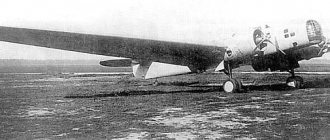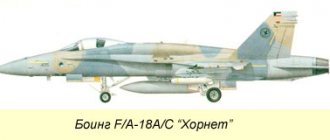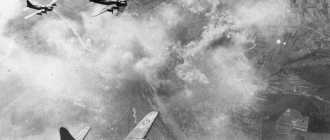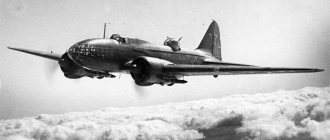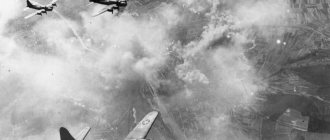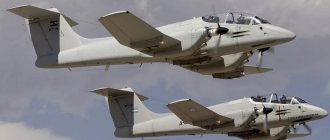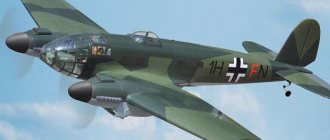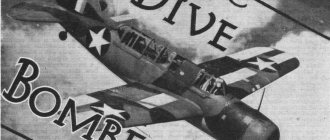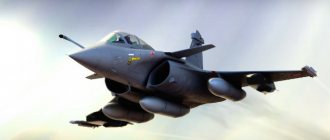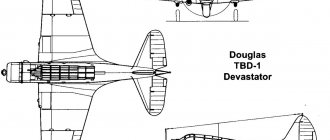One of the most famous twin-engine bombers of World War II, the Douglas DB-7/A-20 Havoc/Boston had a fairly long history.
In March 1936, on an initiative basis under the leadership of E. Heinemann, the design of a twin-engine attack aircraft under the designation “model 7A” began - an all-metal high-wing aircraft with a retractable three-wheeled landing gear with a nose strut. In 1937, the US Army announced official requirements for the new attack aircraft: a speed of at least 200 miles per hour (322 km/h), a flight range of 1,200 miles (1,930 km), a bomb load of 1,200 pounds (544 kg). The Model 7A met the speed requirements, but had a smaller bomb load. The project was reworked, providing for the installation of more powerful R-1830-S3C3-G engines, doubling the fuel supply, and the estimated bomb load was increased to 908 kg. The forward part of the fuselage could be made glazed, with a workstation for the navigator-bombardier, or solid, with machine-gun batteries (in the first case, the crew consisted of three people, in the second - of two). Defensive armament in both versions consisted of two 7.62 mm machine guns in retractable upper and lower turrets. The aircraft received the designation “model 7B”, and its design was carried out already, which absorbed Northrop, and in which E. Heinemann now worked.
The competition, held in July 1938, did not announce a winner, and the companies participating in it were asked to build one prototype aircraft each for comparative tests. A prototype of the “model 7B” first took to the air on October 26, 1938. During tests, the aircraft demonstrated good speed, excellent maneuverability for a twin-engine aircraft, and the absence of any unpleasant piloting features. The plane flew with both versions of the nose, which were made interchangeable.
And although the American military was in no hurry to purchase the aircraft, and the prototype crashed on January 23, 1939, the Douglas product was a commercial success - the aircraft was ordered by France. On August 17, 1939, a new prototype took off, designated DB-7, modified according to French requirements, and production of production vehicles began in October. Total production was 7,478 aircraft.
Main modifications of the Douglas DB-7/A-20 “Havoc”/“Boston”:
Douglas DB -7 - 14-cylinder Pratt & Whitney R-1830-SC3-G (1000 hp; on the first 130 aircraft) or R-1830-S3C4-G (1200 hp) engines. Small arms - 6 7.5 mm machine guns (4 fixed in the bow, 1 each in the upper and lower mounts). Bomb load weight - 800 kg. Crew - 3 people. According to the French order, 270 aircraft were manufactured, designated DB-7B3 in France. Most of the aircraft, due to the defeat of France, ended up in the UK, where they were designated “Boston” Mk.I (20 aircraft with R-1830-SC3-G engines) and “Boston” Mk.II (aircraft with R-1830-S3C4-G engines ). The aircraft were equipped with 7.7 mm machine guns and British-style avionics. Subsequently converted into Havoc Mk.I night fighters.
Douglas DB -7 A is an analogue of the DB-7 with 14-cylinder air-cooled Wright R-2600-A5B engines (1600 hp). Ordered by France in quantities of 100, all ended up in the UK and were converted into Havoc Mk.II night fighters.
Douglas DB -73 - corresponded to the DB-7A, but received an extended nose. In May 1940, 480 aircraft were ordered for France (240 aircraft were produced and 240 by Boeing). 207 aircraft remained in the USA after the Japanese attack on Pearl Harbor, the rest were delivered to the UK, where they were designated Boston Mk.III.
The Douglas DB -7B the RAF equivalent of the DB-73 (UK designation Boston Mk.III). 300 aircraft were manufactured, 6 of which remained in the United States after the Japanese attack on Pearl Harbor.
Douglas DB -7 C is an analogue of the DB-73 for the Dutch East Indies Air Force. Adapted for use as a torpedo bomber. In May-July 1942, 48 aircraft were manufactured.
Douglas A -20 is the first modification for the US Army Air Forces. Engines R-2600-7 (1700 hp; on 4 aircraft) or R-2600-11. 63 aircraft were ordered, of which 3 were converted into F-3 reconnaissance aircraft and 60 into P-70 night fighters.
Douglas A -20 A - R-2600-3 engines (1600 hp; on 123 aircraft) or R-2600-11. Small arms - 7 7.62 mm machine guns (4 fixed in the forward fuselage, 2 on the top mount, 1 on the bottom mount); Some aircraft additionally had 2 7.62-mm fixed machine guns in engine nacelles that fired backwards. Bomb load weight: 908 kg. Crew - 3 people. Until September 1941, 143 aircraft were produced. 1 vehicle was transferred to the Navy, where it received the designation BD-1 and was used for auxiliary purposes.
Douglas A -20 V - R-2600-11 engines (1600 hp). Small arms - 3 12.7 mm machine guns (2 fixed in the forward part of the fuselage, 1 on the top mount), 1 7.62 mm machine gun on the bottom mount; some of the aircraft additionally had 2 7.62 mm machine guns in the engine nacelles. Bomb load weight: 940 kg. 999 aircraft were produced. 8 vehicles were transferred to the Navy, where they received the designation BD-2 and were used for auxiliary purposes.
Douglas A - 20C is a variant for the US Army Air Forces, unified with the export DB-7B. Engines - R-2600-23 (1600 hp). Small arms are similar to the A-20A (machine guns were not installed in the engine nacelles). Since the spring of 1941, 948 aircraft have been manufactured (808 and 140 Boeing). 200 aircraft were delivered to Great Britain (designated Boston Mk.IIIA).
Douglas A -20 G - R-2600-23 engines (1600 hp). A new, unglazed nose section was used, where 6 12.7 mm machine guns were installed (on the first series of 250 A-20G-1 aircraft, 4 20 mm cannons and 2 12.7 mm machine guns were installed). Defensive armament - 1 12.7 mm machine gun on the upper pivot mount and 1 7.62 mm machine gun on the lower hatch mount; from the A-20G-20 series - 2 12.7 mm machine guns in the upper turret and 1 of the same in the lower mount. The maximum bomb load weight is 1800 kg. Crew -3 people. From March 1943 to June 1944, 2850 aircraft were manufactured.
Douglas A -20 N - corresponded to the A-20G of later series, but with R-2600-29 engines (1600 hp). From February to September 1944, 412 aircraft were delivered.
The Douglas A -20J is an aircraft based on the A-20G with a glass nose. Small arms - 5 12.7 mm machine guns (2 fixed in the bow, 2 on the upper turret, 1 in the lower mount). 450 vehicles were produced, of which 169 were delivered to Great Britain under the designation “Boston” Mk.IV.
Douglas A -20K is an analogue of the A-20J with R-2600-29 engines. From March to September 1944, 413 aircraft were manufactured, of which 46 were F-3A reconnaissance aircraft. 90 A-20K delivered to UK as Boston Mk.V.
Content
- 1 Development
- 2 Modifications 2.1 DB-7
- 2.2 DB-7A
- 2.3 DB-73
- 2.4 Boston Mk I/Mk II
- 2.5 DB-7B Boston Mk III
- 2.6 Havok Mk I/Havok Mk II
- 2.7 Havok Mk I Pandora
- 2.8 Havok Turbinlight
- 2.9 DB-7C
- 2.10 A-20
- 2.11 A-20A
- 2.12 A-20B
- 2.13 A-20C
- 2.14 A-20G
- 2.15 A-20H
- 2.16 A-20J/Boston Mk IV
- 2.17 A-20K/Boston Mk V
- 2.18 P-70
- 2.19 F-3A
- 2.20 Other
- 3.1 France
Technical data
| Modification | A-20G-45 |
| Wingspan, m | 18,69 |
| Length, m | 14,63 |
| Height, m | 4,83 |
| Wing area, m² | 43,20 |
| Weight, kg | |
| empty plane | 8029 |
| normal takeoff | 11794 |
| maximum takeoff | 13608 |
| engine's type | 2 PD Wright R-2600-A5B Twin Cyclone |
| Power, l. With. | 2 x 1600 |
| Maximum speed, km/h | 510 |
| Cruising speed, km/h | 390 |
| Ferry range, km | 3380 |
| Practical range, km | 1610 |
| Rate of climb, m/min | 407 |
| Practical ceiling, m | 7230 |
| Crew | 3 |
| Weapons: | six 12.7 mm forward-firing machine guns, two 12.7 mm machine guns in an electrically driven turret and one 12.7 mm machine gun for firing through a hole in the bottom of the fuselage; normal - 910 kg of bombs in the bomb bay and the same amount on the underwing units |
Combat use
France
DB-7, ordered by France, was transported disassembled by sea to Casablanca, where it was assembled and entered service in North Africa and France itself. By the time Germany attacked France on May 10, 1940, there were 64 aircraft in service, of which only 12 took part in combat operations. In addition to the original order, France ordered a further 200 aircraft with improved engines, but none were delivered. Before the surrender, in order to avoid capture by German troops, all aircraft were sent to North Africa. Some of them came under the control of the Vichy government and were used against the Allies during Operation Torch, while the rest served in the Free French air force. After French troops in Northern France joined the Allies, DB-7s were used as training aircraft, and several aircraft were sent back to France in early 1945, where they were used to suppress resistance from surrounded German troops.
Great Britain
Among the episodes of their military service, one can note the attack of the German ships Scharnhorst, Gneisenau and Prinz Eugen during their breakthrough from Brest across the English Channel (Operation Cerberus), the inglorious raid on Dieppe (Operation Jubilee) and participation in battles in North Africa, where Boston Mk III replaced Blenheims.
USA
| This section of the article has not been written. According to the plan of one or more Wikipedia contributors, a special section should be located in this place. You can help by writing this section. This mark was set on March 2, 2022 . |
USSR
Douglas A-20G Boston, USSR Air Force
A total of 3066 units were delivered to the USSR under Lend-Lease. A-20 of various modifications.
In the second half of 1943, the Moscow aircraft plant began modernizing the Boston bombers, during which the 7.62-mm Colt-Browning machine gun in the radio operator’s cockpit was replaced with a Soviet 12.7-mm Berezin machine gun, and the bomb racks were also replaced ( for the possibility of using all types of Soviet aerial bombs)[2].
Deliveries of these vehicles began in 1943 via two routes - through Alaska and Iran. We called them A-20Zh, hence the nickname “Bug”.
The first A-20G appeared on the Soviet-German front in the summer of 1943. This type became a truly multi-purpose aircraft in our aviation, performing a variety of functions - day and night bomber, reconnaissance aircraft, torpedo bomber and minelayer, heavy fighter and even transport aircraft. It was rarely used only as an attack aircraft - for its main purpose[3].
They tried to use these aircraft for bombing attacks on enemy positions, vehicles on the roads, trains and airfields. It turned out that the "Bug" is very vulnerable to anti-aircraft fire at low altitudes, due to its considerable size and weak armor cover. Only when surprise was achieved could one count on comparative safety during an attack in the conditions of well-functioning German air defense. Nevertheless, Soviet pilots periodically carried out assault strikes on convoys, trains and ships. The crews of the 449th Regiment in such a situation usually attacked from a height of 300-700 m, diving at an angle of 20-25°. After a burst of 20-30 shells, a quick departure at low level followed.
Participated in air battles in Kuban in 1943.
Aircraft equipped with the Gneiss-2 radar were used as night fighters. They were armed with the 56th Long-Range Fighter Aviation Division. In Navy aviation, radar-equipped aircraft were used to search for surface ships.
They were also used in the aviation units of the Baltic Fleet (in particular, the 51st mine-torpedo air regiment was fully equipped with such aircraft). The Pacific Fleet also had them and were in service with the 49th Mine-Torpedo Aviation Regiment of the Pacific Fleet Air Force.
In the Soviet Union, the Bostons successfully served until the very end of the war. They participated in all major operations of the final period - Belarusian, Iasi-Kishinev, East Prussian and many others, fought in the skies of Poland, Romania, Czechoslovakia, Germany. On May 1, 1945, the Soviet Air Force had 935 Bostons. More than two thirds of them were G modification vehicles.
On April 22, Soviet Bostons dropped bombs on Berlin for the first time.
The 221st Division worked in the offensive zone of the 8th Army, in particular, it supported the assault on the Seelow Heights. The 57th Regiment flew even in poor visibility conditions, when the aircraft of other units were on the ground. 23 crews, despite low, continuous clouds, bombed artillery and mortar batteries near Gelesdorf. The next day, Lieutenant Gadyuchko’s unit destroyed the crossing of the Spree.
Development
Douglas A-20 Havoc
In 1936, the Douglas Aircraft Company began designing a new aircraft to replace aging single-engine bombers. The project was led by Donald Douglas, Jack Northrop and Ed Heinemann. The aircraft under development, which received the corporate designation Model 7A
, was a twin-engine high-wing aircraft with Pratt & Whitney R-985 engines producing 450 hp. With. and was supposed to carry 1,000 pounds (454 kg) of bombs and reach a speed of 400 km/h. However, the Spanish Civil War showed the insufficiency of these characteristics, and the project was discontinued.
In the fall of 1937, the US Army Air Corps released specifications for a new attack aircraft. To participate in the competition, a group of Douglas designers led by Ed Heinemann redesigned the Model 7A
, equipping it with more powerful Pratt & Whitney R-1830 Twin Wasp engines with a power of 1100 hp.
s.. The new aircraft was designated Model 7B
.
The aircraft had a three-post landing gear with a nose wheel, which was unusual for the time, and had interchangeable forward fuselage sections for attack aircraft or bomber variants. The Model 7B
was faster and more maneuverable than its competitors, the North American NA-40, Stearman X-100 and Martin 167F, but there were no orders from the US Army Air Corps.
This aircraft, however, attracted the attention of the procurement commission for the French Armed Forces. The French observed the flight tests in secret, fearing attacks from supporters of US isolationist policies, but the secret was revealed after the crash of the Model 7B
January 23, 1939 during a demonstration of flight on one engine. The French, however, ordered 100 aircraft, increasing the order to 270 after the outbreak of war in Europe.
For the French order, the aircraft was significantly redesigned and received a new designation DB-7
(eng. DB-7 Douglas
Bomber
-
7
-
Douglas
Bomber -
7
)
. It was equipped with French-made machine guns, the fuselage became taller and narrower to increase the internal bomb bay, the high wing was converted into a mid-wing, the cockpit and fuel tanks received armor protection.
Surviving copies
In December 2016, the Douglas A-20 Havoc/DB-7 Boston bomber was discovered at the bottom of the Black Sea in the search and rescue zone after the crash of a Tu-154 aircraft[4]. Using archival documents, it was possible to establish the date of the disaster—November 15, 1942—and its dead crew[5].
In May 2022, a Douglas DB-7 Boston/A-20 bomber was discovered at the bottom of the Gulf of Finland during the construction of the Nord Stream 2 gas pipeline. The plane was found at a depth of 100 meters, without significant damage[6]. Nord Stream 2 AG carried out video recording of the aircraft at the bottom of the bay[7].
